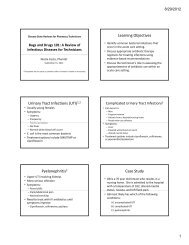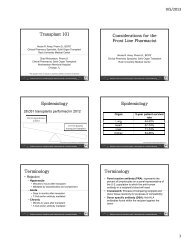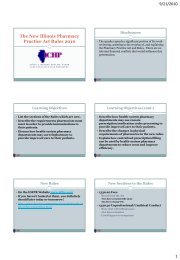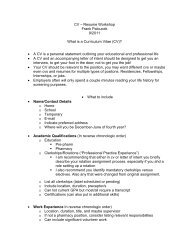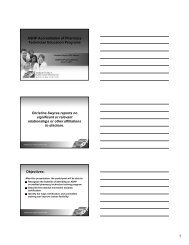Presentation Outline ICHP Annual Meeting September 13-15
Presentation Outline ICHP Annual Meeting September 13-15
Presentation Outline ICHP Annual Meeting September 13-15
You also want an ePaper? Increase the reach of your titles
YUMPU automatically turns print PDFs into web optimized ePapers that Google loves.
Putting Patient Safety First:<br />
Trends in Adverse Drug Event<br />
Screening and Reporting<br />
Charlene A. Hope, PharmD, BCPS<br />
Izabella Wentz, PharmD, FASCP ‐ Moderator<br />
Learning Objectives<br />
TECHNICIANS<br />
1. Explain the difference between safety outcomes: adverse<br />
drug events, potential adverse drug events, medication side<br />
effects and medication errors.<br />
2. Identify three different approaches to Adverse Drug Event<br />
screening. i<br />
3. Name the types of outcomes associated with Adverse Drug<br />
Events.<br />
4. Review a tool implemented across various patient care<br />
settings for potential Adverse Event screening.<br />
5. Name two therapeutic and safety outcome measures.<br />
QIO Medication Safety Initiatives<br />
• Prescribing of<br />
PIM’s<br />
• PDP’ PDP’s/pharmacies<br />
/ h i<br />
/physicians<br />
8th SOW:<br />
2005‐2008<br />
PIM-Potentially Inappropriate Medication<br />
PDP-Medicare Prescription Drug Plan<br />
ADE-Adverse Drug Events<br />
9<br />
•Drug interactions<br />
th SOW:<br />
2008‐2011 •ADE’s & outcomes<br />
g<br />
• Clinical Pharmacy<br />
& PIM’s<br />
S Services i<br />
•PDP’s & Providers<br />
10th SOW:<br />
2011‐2014<br />
Learning Objectives<br />
PHARMACISTS<br />
1. Differentiate between safety outcomes: adverse drug<br />
events, potential adverse drug events, medication side<br />
effects and medication errors.<br />
2. Identify three different approaches to Adverse Drug Event<br />
screening.<br />
3. Discuss current economic, clinical and humanistic<br />
outcomes associated with adverse drug events.<br />
4. Evaluate a tool implemented across various patient care<br />
settings for potential Adverse Event screening.<br />
5. Describe the types of therapeutic and safety measures<br />
that should be tracked to justify the expansion of clinical<br />
pharmacy services.<br />
About Quality Improvement<br />
Organizations<br />
• Telligen is the Medicare Quality Improvement Organization<br />
(QIO) for the state of Illinois, under contract with the Centers<br />
for Medicare & Medicaid Services (CMS).<br />
– Largest federal program dedicated to improving health quality at<br />
the community level<br />
• 1982:Peer Review Organizations (PRO’s) created by Congress<br />
• 1992: Medicare work of PRO’s redirected to Quality Improvement<br />
• 2002: Change of moniker to QIO to reflect mission<br />
– Work in three year long “Statements of Work” to improve care<br />
provided to Medicare beneficiaries<br />
– Provide technical assistance, resources and tools to providers<br />
and facilities throughout the state<br />
Check Point<br />
How many people are injured or die in hospitals<br />
each year from adverse drug events (ADEs)?<br />
0 000<br />
A. 770,000<br />
B. 220,000<br />
C. 560,000<br />
D. 1,200,000<br />
8/29/2012<br />
1



